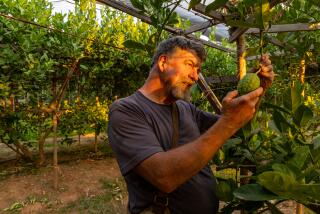A snappy fall lineup with crisp additions
- Share via
Peaking
Jerusalem artichokes: It’s not an artichoke, it’s a tuber and it’s not from Jerusalem but from North America. Regardless, Jerusalem artichokes, also marketed under the name “sunchokes” (thanks to distributor Frieda Caplan, queen of the kiwi fruit), are a welcome addition to the cold weather vegetable lineup. They are crisp in texture even if they are a little bland in flavor. Use them raw as a dipping vegetable, like jicama that’s not so sweet (I like to add them to a pinzimonio assortment for dipping in olive oil). Cook them gently and you can use them as a nuttier, sweeter replacement for potatoes -- they’re delicious pureed with butter. Vegetable expert Elizabeth Schneider recommends choosing the smallest, darkest-skinned ones to get the best flavor. A point of caution: After peeling, place them in a bowl of acidulated water -- apparently the one characteristic they do share with artichokes is a tendency to blacken when exposed to air.
Coleman Family Farms, $4 per pound.
Asian pears: There are several important varieties with different characteristics. Probably the most common, at least in the United States, is the Hosui, which is a large, round russet pear with a tender, grainy flesh and honeyed perfume. Shinseiki, which along with the Hosui is harvested in the early fall, is smooth-skinned with a bright yellow color and crisp, apple-like texture. Starting about now we’re seeing Nijisseiki, or “Twentieth Century” pears, which are a pale greenish-yellow even when ripe, and have a crisp texture. Those are all Japanese varieties. Just coming in is the Chinese pear called Ya Li, the only popular Asian pear that is “pear-shaped.” It is crisp and mild in flavor.
Various vendors, $2 per pound.
-- Russ Parsons
More to Read
Eat your way across L.A.
Get our weekly Tasting Notes newsletter for reviews, news and more.
You may occasionally receive promotional content from the Los Angeles Times.










